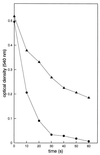Electrophoretic mobility distributions of single-strain microbial populations
- PMID: 11157207
- PMCID: PMC92611
- DOI: 10.1128/AEM.67.2.491-494.2001
Electrophoretic mobility distributions of single-strain microbial populations
Figures




Similar articles
-
Significance of electrophoretic mobility distribution to bacterial transport in granular porous media.J Microbiol Methods. 2002 Sep;51(1):83-93. doi: 10.1016/s0167-7012(02)00062-3. J Microbiol Methods. 2002. PMID: 12069893
-
The effect of ionic strength on the electrophoretic mobility and protonation constants of an EPS-producing bacterial strain.J Colloid Interface Sci. 2010 Aug 15;348(2):348-54. doi: 10.1016/j.jcis.2010.04.082. Epub 2010 May 23. J Colloid Interface Sci. 2010. PMID: 20546767
-
Homeland security and bioterrorism applications: detection of bioweapon pathogens by microfluidic-based electrophoretic DNA analysis.MLO Med Lab Obs. 2004 Feb;36(2):34-8. MLO Med Lab Obs. 2004. PMID: 15002151 No abstract available.
-
[Implication of viable but nonculturable (VNC) concept].Nihon Rinsho. 2007 Feb 28;65 Suppl 2 Pt. 1:674-8. Nihon Rinsho. 2007. PMID: 17455703 Review. Japanese. No abstract available.
-
Physical methods for characterization of microbial surfaces.Experientia. 1989 Dec 1;45(11-12):1047-55. doi: 10.1007/BF01950157. Experientia. 1989. PMID: 2689202 Review.
Cited by
-
Specific molecular recognition and nonspecific contributions to bacterial interaction forces.Appl Environ Microbiol. 2008 May;74(9):2559-64. doi: 10.1128/AEM.02839-07. Epub 2008 Mar 14. Appl Environ Microbiol. 2008. PMID: 18344352 Free PMC article. Review. No abstract available.
-
Influence of surface characteristics on the stability of Cryptosporidium parvum oocysts.Appl Environ Microbiol. 2003 Jul;69(7):3819-25. doi: 10.1128/AEM.69.7.3819-3825.2003. Appl Environ Microbiol. 2003. PMID: 12839749 Free PMC article.
-
The cell wall of lactic acid bacteria: surface constituents and macromolecular conformations.Biophys J. 2003 Dec;85(6):4076-92. doi: 10.1016/S0006-3495(03)74820-6. Biophys J. 2003. PMID: 14645095 Free PMC article.
-
Influence of culture heterogeneity in cell surface charge on adhesion and biofilm formation by Enterococcus faecalis.J Bacteriol. 2006 Apr;188(7):2421-6. doi: 10.1128/JB.188.7.2421-2426.2006. J Bacteriol. 2006. PMID: 16547028 Free PMC article.
-
Enhancing transport of hydrogenophaga flava ENV735 for bioaugmentation of aquifers contaminated with methyl tert-butyl ether.Appl Environ Microbiol. 2002 Nov;68(11):5571-9. doi: 10.1128/AEM.68.11.5571-5579.2002. Appl Environ Microbiol. 2002. PMID: 12406751 Free PMC article.
References
-
- Bos R, van der Mei H C, Busscher H J. Physico-chemistry of initial microbial adhesive interactions—its mechanisms and methods for study. FEMS Microbiol Rev. 1999;23:179–229. - PubMed
-
- Busscher H J, Bellon-Fontaine M N, Mozes N, van der Mei H C, Sjollema J, Cerf O, Rouxhet P G. Deposition of Leuconostoc mesenteroides and Streptococcus thermophilus to solid substrata in a parallel plate flow cell. Biofouling. 1990;2:55–63.
-
- Busscher H J, van de Belt-Gritter B, van der Mei H C. Implications of microbial adhesion to hydrocarbons for evaluating cell surface hydrophobicity. 1. Zeta potentials of hydrocarbon droplets. Colloids Surf B. 1995;5:111–116.
-
- Busscher H J, Bos R, van der Mei H C, Handley P S. Physicochemistry of microbiol adhesion from an overall approach to the limits. In: Baszkin A, Norde W, editors. Physical chemistry of biological surfaces. New York, N.Y: Marcel Dekker; 2000. pp. 431–458.
-
- Cowan M M, van der Mei H C, Stokroos I, Busscher H J. Heterogeneity of surfaces of subgingival bacteria as detected by zeta potential measurements. J Dent Res. 1992;71:1803–1806. - PubMed
Publication types
MeSH terms
Substances
LinkOut - more resources
Full Text Sources
Molecular Biology Databases

